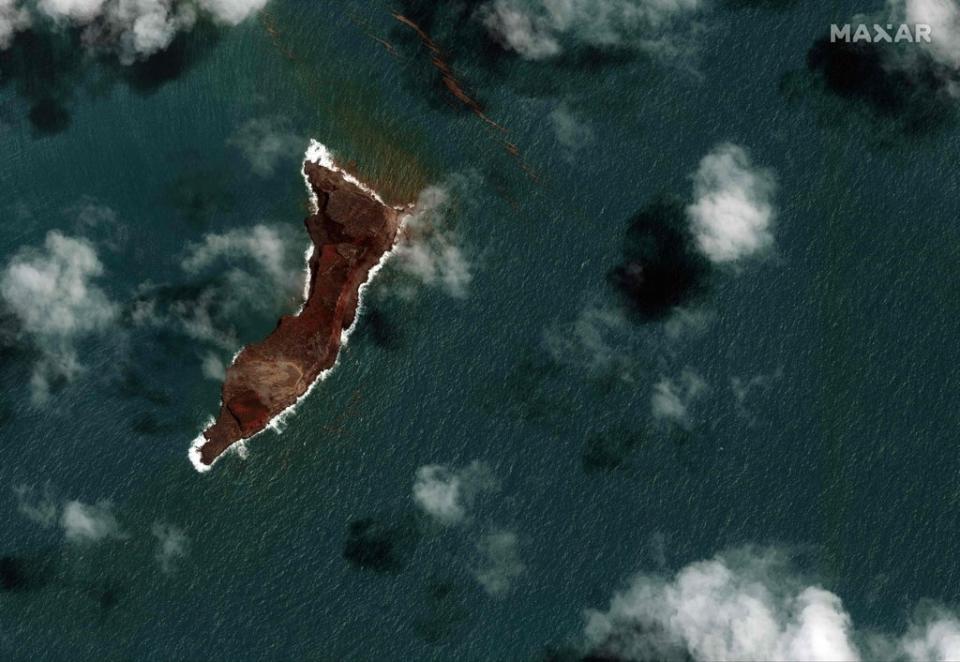Tonga: New Zealand military photographs reveal scale of devastation from volcano
Tonga's outer islands suffered extensive damage, with an entire village destroyed and several buildings missing, following an underwater volcanic eruption that triggered a tsunami.
Aerial images taken by the New Zealand defence force showed the aftermath of the colossal devastation inflicted by the tsunami on the south Pacific island nation.
Vast areas of the islands were covered in a blanket of thick ash and most coastal buildings destroyed, the photographs showed.
The eruption of volcano Hunga Tonga-Hunga Ha’apai off Tonga prompted tsunami warnings around the Pacific, which receded on Sunday.
According to the notes on the images, some areas of the islands suffered "catastrophic damage".
The Fonoifua island sustained “extensive damage" with "all but the largest buildings destroyed or severely damaged.”
In Atata island, a large number of buildings were "missing," while "remaining structures probably had flood damage," the assessment said.
The Mango island with a population of 50 suffered “catastrophic damage” with the entire village destroyed. "Temporary tarpaulin shelters had been erected on the island’s higher areas. Debris was observed throughout the village,” said the assessment.

A distress signal was reportedly detected from Mango island, which was hit by waves estimated to be 5-10 meters high, according to the Tongan navy. Atata and Mango are located between about 50 and 70 km from the Hunga Tonga-Hunga Ha'apai volcano.
Meanwhile, thick ash on the runway has hampered relief efforts to Tonga. New Zealand’s military said its flight with drinking water and other supplies would be delayed by at least a day due to the blanket of ash on the runway.
New Zealand also sent a navy ship to Tonga on Tuesday with another planned to leave later in the day. Australia too sent a navy ship from Sydney to Brisbane to prepare for a support mission if required.
Tonga police informed the New Zealand High Commission that the confirmed death toll stood at two, however, due to severed communications, the true extent of casualties was not clear.
"People panic, people run and get injuries. Possibly there will be more deaths and we just pray that is not the case," Tonga’s deputy head of mission in Australia, Curtis Tu’ihalangingie, told Reuters.
He added: "It is very alarming to see the wave possibly went through Atata from one end to the other".

Earlier satellite images showed plumes of ash and dust over Tonga, with smoke rising about 12 miles above sea level. The eruption was reportedly so loud that residents in faraway Fiji and New Zealand said they heard it.
According to the National Weather Service, the sonic boom could be heard as far away as Alaska and sent pressure shockwaves around the planet twice. Large waves were detected as far away as the Caribbean due to pressure changes generated by the eruption.
The United Nations earlier reported extensive damages in Tongatapu. The capital Nukuʻalofa remained largely undamaged apart from the waterside.
British national Angela Glover, 50, was the first identified casualty in the tsunami.
The archipelago has remained largely cut off from the world after the eruption severed its undersea communications cable.
Lord Fakafanua, the nation’s speaker of the Assembly, asked for “immediate assistance” of fresh water and food.
“Communications remain down and the full extent of the harm to lives and property is currently unknown. What we do know is that Tonga needs immediate assistance to provide its citizens with fresh drinking water and food,” he said, in a statement shared on social media.

